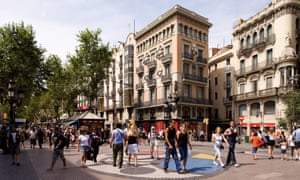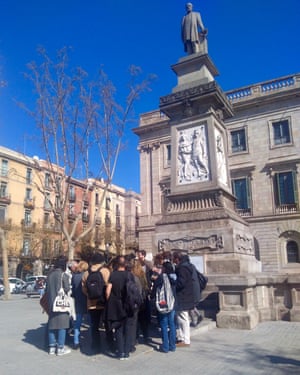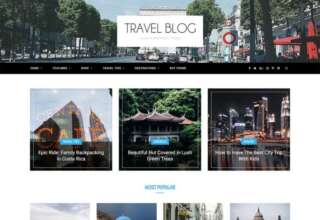A tour of the Ramblas and Gothic Quarter highlights a dark part of Barcelona’s past, including how many of its famous sights were built with fortunes made from slavery

Modernisme, Catalonia’s stunning take on art nouveau, is as important to the Barcelona brand as Barça striker Lionel Messi. The work of Antoni Gaudí in particular defines much of the city centre but few locals, let alone the tourists queueing to get into world-famous sights such as Palau Güell and Park Güell, know their dark secret: many were built with money made from the slave trade.
Nations are adept at swerving uncomfortable episodes in their history and Spain is no exception – the civil war’s legacy, for example, was not confronted for decades after Franco’s death. But times are changing: money has been spent on finding mass war graves, and Spain and Catalonia’s role in slavery is getting more attention. Barcelona has a radical new mayor, Ada Colau, who made her name as a social activist, and the city council is supporting a new walking tour of places with a slave history.
“Es una memoria incómoda – an uncomfortable memory,” said historian Oriol López. “It’s not taught in schools here and it’s still not something some those in authority want to look at.”

López works at the Barcelona-based European Observatory of Memories, which created the tour with the University of Barcelona and the Knowing History Association.
The slave trade boomed in the 19th century. Many people left Spain and Cataloniaas paupers and returned years later from colonies like Cuba as millionaires, but the city’s elite sneered and nicknamed them los indianos. They spent big on mansions and married into respectable bourgeois Catalan families suffering from cashflow problems.
My tour started near Plaça de Catalunya at the statue of Joan Güell and ended near the harbour at the statue of Antonio López – industrialist, banker, philanthropist and Catalonia’s most notorious slave trader. Güell made his fortune in Cuba. “We don’t know if Güell was a negrero (a slave-trader),” said Oriol. “We have records for López, but other families of indianos were ashamed of their slavery past and erased the evidence.”

Güell’s son, Eusebi, married López’s daughter and became one of the richest men in Spain. He met Gaudí and so began a relationship that created some of the finest examples of modernisme.
Oriol led me down through Plaça de Catalunya, where the first demonstrations calling for the abolition of slavery were held in the 1870s, to the Ramblas and into the Barri Gòtic, including Plaça Sant Jaume and Plaça de Rei, tourist favourites, to explain how slavery has played a big part in Barcelona history through the ages. It’s estimated that 10% of the city’s population in medieval times were slaves.
Finally, we reached the harbourside. The famous seafood restaurant 7 Portes is on the ground floor of an impressive block built by an indiano called Josep Xifré and decorated with sculptures referencing his lucrative time in the Americas.
Nearby is Plaça d’Antonio López – they named a square after him – and his statue. The pedestal was daubed with red paint that dripped like blood down the steps next to the words “Africa free”.
The statue was, like Güell’s, ripped down in the civil war but rebuilt on Franco’s orders. There are regular campaigns to have the square renamed and the statue removed but for the moment protesters have to make do with occasional demos here, a bit of paint throwing – and now this tour.


















